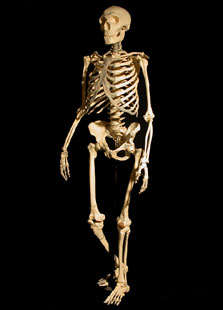Neandertal skeleton (first reconstruction)

The first reconstruction of an adult Neandertal skeleton from fossil casts. Reconstruction by G.J. Sawyer and B. Maley.
maley,reconstruction,fossil,evolution,adult
- ID: 15595
- Source: DNALC.DNAi
Related Content
15973. Making of the Neandertal
In 2002, the first reconstruction of an adult Neandertal skeleton was displayed at the Dolan DNA Learning Center, Cold Spring Harbor Laboratory
15972. Comparing humans and Neandertals
In 2002, the first reconstruction of an adult Neandertal skeleton was displayed at the Dolan DNA Learning Center, Cold Spring Harbor Laboratory. It is a male Neandertal, composed mainly of casts from four fossil finds: La Ferrassie (France), Kebara (Israe
15599. Neandertal burial remains
Cast of a 60,000 year-old Neandertal fossil. Fossils like this one raise questions about Neandertal burial practices.
15164. Fossils and human origins, Mark Stoneking
Geneticist Mark Stoneking, co-author of an early mitochondrial DNA paper, talks about the competing theories of human origins.
15196. Modern humans and Neandertals? Chris Stringer
Human origins expert Chris Stringer talks about the relationship between Neandertals and humans.
15197. Are Neandertals our ancestors?, Chris Stringer
Human origins expert Chris Stringer talks about if Neandertals are our ancestors
15847. Modern humans: a late arrival, still image with audio
Modern humans: a late arrival, still image with audio
15189. Views of human evolution, Chris Stringer
Human origins expert Chris Stringer talks about the beginning of the hominid family tree using an exhibit currently installed at the Dolan DNA Learning Center, Cold Spring Harbor Laboratory.
15892. Human migrations map, interactive 2D animation
The red lines show the possible migration pathway of the ancient human Homo erectus (sometimes known as Homo ergaster). There is little controversy about the travels of H. erectus. This possible path was mapped using fossil evidence that spans more than 1
16886. The Primate Fossil Ida – Science Review
Paleontologist Tim White and David Micklos discuss Ida (Darwinius masillae), the 47 million year-old primate fossil. Ida, who most closely resembles the modern lemur, may be important to understanding evolution and human origins. However, media publicity












